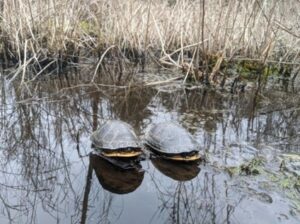The summer of 2022 has seen severe drought all across Massachusetts. According to the U.S. Drought Monitor, almost the entire state is in Severe or Extreme Drought, even after a week of respectable rainfall for the first time in months. All around, you can see dried and stunted plants, trees with large clumps of dead or dying leaves well before autumn sets in, and rivers, lakes, and ponds with large areas of their banks exposed by falling water levels. This lack of water has serious consequences for the many living things that depend on it across the Commonwealth, and the wildlife we work with are no exception.

Most turtles in Massachusetts are directly dependent on healthy waterways to make their living. With the exception of box turtles, all our turtle species are aquatic or semi-aquatic. Wood turtles forage extensively on land, but still return to rivers and brooks to shelter from predators and regulate their temperature. Spotted turtles and Blanding’s turtles spend most of their time in the water, and all three of these species are much faster swimmers than they are runners. Lower water levels means fewer foraging opportunities for these turtles, and also a harder time hiding or fleeing from predators. Otters, mink, raccoons, herons, and other turtle-eating predators know that droughts concentrate prey into a smaller area, making them easier to find and catch.

Less food to eat and less space to hide from predators is bad enough news, but there’s also a more insidious threat posed by drought: nest failure. Turtle eggs might seem like perfect little self-contained worlds, but eggs are constantly maintaining a delicate balance of gas and moisture with their surroundings. An eggshell has thousands of pores that allow oxygen to enter, carbon dioxide to escape, and water to reach a balanced concentration both inside and outside the eggshell. This means that, if the soil an eggs is buried in gets too wet, water will flood the egg, possibly drowning the embryo. If the soil is too dry, water will actually be sucked out through the pores in the eggshell, and the embryo will desiccate and die. This is, distressingly, exactly what happens to large numbers of turtle nests during drought years.

2016 was a prime example of this phenomenon. Our headstarting effort and staff complement were smaller back then, but the drought was comparable in extent and duration. Of 37 eggs protected in four nests in 2016, only 8 hatched – a dismal 22% success rate. Fortunately, there are options available to wildlife managers in desperate times such as these. One of the most effective is to simply water the nests, just like you might water your garden at home. Adding a shower of water to the soil around our protected nests during the hottest, driest stretches helps buffer the eggs against drying out and keeps them viable. This year, we have so far dug up seven protected nests with 82 total eggs. With nest watering, 66 out of those 82 eggs remained healthy and viable until hatching – an 80% success rate. The hard work of our staff and volunteers who took extra time from their schedules to lug watering cans out to turtle nests has clearly paid off, and we will continue to do everything in our power to help wildlife succeed against tough odds.
